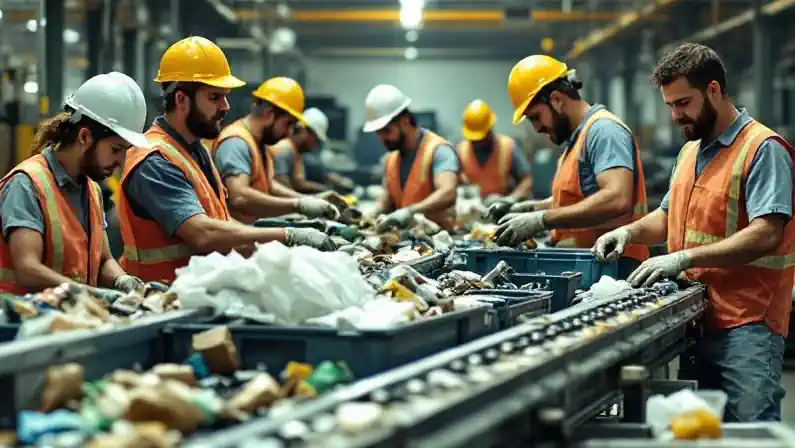Recycling helps the planet. But, sorting waste can be hard work. Efficient Waste Picking Line Systems make it easier. They help sort recyclable waste fast and safely. One fact to know is that the manufacturers: RPM and WRT offer custom-made stations for this job. 3
Waste picking line systems increase sorting speed and are redesigned to keep workers safe. This post will show how they do that. Keep reading to learn more.
Key Takeaways for Waste Picking Line Systems
- Waste picking systems sort out recyclables fast and safely. They use conveyor belts, robots, and workers.
- Picking stations can be mobile or fixed. Mobile ones move easily. Fixed ones focus on specific tasks.
- Robots and AI make sorting quicker and cut mistakes. This helps recycle more things properly.
- New smart designs keep workers safer and reduce strain. Custom options match different recycling needs.
- These systems mean less waste goes to landfills. This is good for the planet.
Overview of Waste Picking Line Systems in Recycling Facilities

A recycling facility with efficient waste picking line and workers sorting items.Waste picking line systems sort trash into reusable items and rubbish. They use conveyor belts, sorting bins, and workers to do this job.
Applications in recycling operations
In recycling operations, picking stations play a vital role. They sort out paper, plastics, and metals from mixed recyclables. This happens at Material Recycling Facilities (MRFs). 1 Workers stand by conveyor belts. They pick out items that machines might miss. Some materials go on to be composted or used in mechanical biological treatment (MBT). 1 It is precise work that keeps harmful items out of the environment.
These systems use variable speed controls to manage how fast items move. Canvas enclosures or permanently covered picking lines protect workers from weather and noise. Safety gear helps them avoid injuries at nip points or drop chutes.
This careful sorting leads to less waste in landfills and more reuse and recycle actions.
Key processes and functionalities
Waste picking lines sort materials like metal, plastic, paper, glass, and e-waste. This makes recycling easier. Machines separate items using sensors and magnets. Sensors find different materials.
Magnets pull out metal things.
Robots help too. They pick up recyclable bits fast and without mistakes. This means more items get recycled properly. Workers are safer because robots do the dangerous parts of their jobs. Everything works better with less harm to our planet. 2
Types of Picking Stations
Picking stations come in different shapes and sizes, each fitting a specific task. They range from mobile units that move about to fixed spots, and even high-tech lines that sort items by themselves.

Mobile Picking Stations
Mobile picking stations give businesses the power to move their waste sorting anywhere. This means they can change locations easily, either around one site or to different places. 3 They're perfect for handling more work or changing how a place is set up without big costs. Safety and comfort for workers are key parts of these stations' designs. They help keep injuries down. 3
These stations also grow with your business, so you don't have to worry about them getting outdated quickly. Because they make sorting faster and better, companies get more done in less time.
This boosts how well the operation runs from start to finish.
Static Picking Stations
Static picking stations fit specific company needs closely. 4 They come as single-sided or double-sided designs. This setup aims to keep productivity high and equipment running well.
These systems are strong and can change for different jobs. They help lower costs and make equipment last longer.
In waste management, static recycling systems stand out for their lasting design and cost savings. Companies choose them to sort waste better, keep workers safe, and lessen harm to the environment.
With options like permanent enclosures, these units show a consultative approach in the recycling industry.
Automated Materials Sorting Lines and Smart Picking
Automated materials sorting lines improve waste recycling greatly. Recycleye and FANUC UK teamed up to create an advanced sorting system for dry mixed recyclables. This system uses Recycleye's AI vision technology along with FANUC's LR Mate robots.
It boosts sorting accuracy by 12% and enhances line output by 10%. 5
The LR Mate robot can sort 33,000 items in just ten hours. It works day and night, using five times less energy than regular Delta robots. With smart picking methods like this, recycling operations become more efficient.
They help reduce waste and support the goal of reducing, reusing, and recycling in our communities. 6
Innovations in Manual Picking Line Systems
Innovations in manual picking line systems enhance efficiency and comfort for workers. New ergonomic stations make the job easier, while smart sorting tools help separate waste quickly.

Ergonomically Designed Picking Stations
Ergonomically designed stations make waste picking safer. They reduce the risk of injuries by lessening heavy lifting. These setups allow workers to sort materials with ease. The design focuses on comfort and efficiency, which boosts productivity. 3
These stations can adjust to fit different tasks. This flexibility matches various recycling needs and improves operations in recycling facilities. Overall, ergonomics enhance user friendliness and support better waste management solutions for a more sustainable future.
Automated Sorting Technologies
Automated sorting technologies are transforming recycling operations. AI-powered optical sorting systems use high-resolution cameras and machine learning to sort materials accurately. 7 This technology increases efficiency in waste management equipment by categorising items quickly.
Near-infrared (NIR) technology separates plastics by their polymer types, improving material quality. Robotics enhance accuracy and speed in sorting tasks, reducing errors during the recycling process. 8 These advancements mean facilities can handle more waste while lowering environmental impact. With efficient automated systems, we can better recycle, reduce, and reuse resources for a cleaner future.
Customisation Options for Specific Needs
Customisation options are key for effective waste picking systems. Companies can assess their specific needs through a free site survey. 9 This helps find solutions that fit their operations well.
Custom solutions include various types of equipment and workflows, which makes recycling easier.
Recycling facilities benefit from customised designs like unique sorting lines or varied picking stations. These adjustments improve efficiency in sorting waste. The focus is on reducing environmental impact while ensuring worker safety.
A money-back guarantee offers peace of mind, as clients know they can receive a refund if the system doesn’t work as promised—plus, removal is free if needed. 10
Benefits of Efficient Waste Picking Systems
Efficient waste picking systems boost sorting speed. They keep workers safe and help the planet too. Want to know more benefits? Keep reading!

Increased Sorting Efficiency
Waste picking systems boost sorting efficiency. Robots, like those using Recycleye Vision, sort materials quickly and accurately. 11 They can make up to 33,000 picks in just 10 hours.
This speed outmatches human workers significantly. With AI-driven technology, these systems recognise 28 types of recyclable materials with ease.
Efficient waste recycling equipment improves overall performance in facilities. By reducing labour shortages, robotic solutions ensure better planning and resource use in Material Recovery Facilities (MRFs).
The impact on recycling operations is clear—higher efficiency leads to more effective reuse of resources. Next, let’s look at the different types of picking stations available. 11
Enhanced Worker Safety
Enhanced worker safety is vital in recycling operations. Waste pickers face many health risks due to exposure at landfills. Studies show they are 1.7 times more likely to develop health disorders from this exposure. 12 Increased days working at these sites raise the risk of illness even further.
To improve safety, supportive policies must be in place. Adequate personal protective equipment (PPE) is essential for shielding workers from hazards. Using ergonomic designs and automated sorting technologies can also help reduce strain on workers, making their tasks safer and easier. 11 Focused efforts here contribute to a healthier workplace and support the principles of reduce, reuse, recycle.
Reduced Environmental Impact
Efficient waste picking systems cut down the impact on our planet. Automated sorting solutions help lower toxins and greenhouse gas emissions from landfills. 11 By increasing recycling rates, these systems reduce waste volume.
This leads to better use of resources and supports sustainable management of natural assets. Integrating robotic solutions in materials recovery facilities improves performance even more.
They optimise resource usage while minimising environmental harm.
Next, let’s explore innovations in manual picking line systems.
Conclusion to “Waste Picking Line Systems”
Efficient waste picking line systems greatly improve recycling operations. These setups help in sorting materials quickly and safely. Specific stations meet individual needs and enhance worker safety.
By investing in these technologies, businesses can reduce their environmental impact too. Contact RPM or WRT for solutions that fit your requirements.
You might also find it worthwhile to read our article about informal waste workers: Unsung Heroes of the Global Waste Economy.
Waste Picking Line Systems FAQs
1. What are efficient waste picking line systems for recycling operations?
Efficient waste picking line systems for recycling operations are advanced setups that sort and process waste materials effectively, using the internet to monitor and manage their performance.
2. How does the internet help in managing these systems?
The use of the internet allows remote management of these systems, enhancing efficiency by allowing real-time monitoring and adjustments to improve productivity.
3. Can third-party cookies be recycled through these systems?
Third-party cookies aren't physical wastes but digital data stored on your computer when you visit a site. So, they can't be processed through waste picking line systems for recycling operations.
4. How do efficient waste picking line systems benefit recycling operations?
These highly efficient systems streamline sorting processes, reduce manual labour requirements, and increase recovery rates of recyclable materials – all contributing to more productive and profitable recycling operations.
References:
- ^ https://www.hse.gov.uk/waste/processing.htm (2023-08-29)
- ^ https://recyclinginside.com/recycling-technology/separation-and-sorting-technology/
- ^ https://the-mkgroup.com/news/mobile-picking-stations-5-reasons-to-invest/
- ^ https://www.crsni.com/static
- ^ https://packagingeurope.com/news/ai-robotic-picking-technology-aspires-to-optimise-recycling-operations-and-address-labour-shortages/10184.article (2023-08-14)
- ^ https://www.ncbi.nlm.nih.gov/pmc/articles/PMC9330998/ (2022-07-28)
- ^ https://recyclinginside.com/recycling-technology/separation-and-sorting-technology/innovations-in-advanced-sorting-technologies-for-recyclable-materials/ (2024-01-26)
- ^ https://www.sciencedirect.com/science/article/pii/S0921344923005098
- ^ https://www.coveya.co.uk/content/uploads/2020/10/Coveya-Recycling-Waste-Management-Brochure-Spreads.pdf
- ^ https://link.springer.com/article/10.1007/s10311-023-01604-3
- ^ https://digileaders.com/the-benefits-of-waste-sorting-robots-in-recycling-facilities/ (2022-03-29)
- ^ https://www.ncbi.nlm.nih.gov/pmc/articles/PMC8424242/







